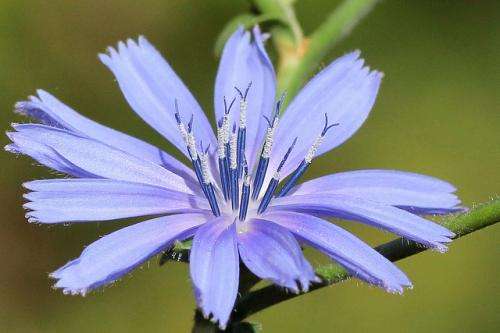Autumn-sown crops produce better yield

Sowing non-legume perennial pastures such as chicory [Cichorium intybus L.] in early autumn rather than spring could increase productivity, according to CSIRO agricultural scientists.
The study, part of the EverCrop project conducted by the Future Farm Industries CRC at UWA, explored incorporating four perennial pastures into mixed farming systems in a uniform rainfall region in southern NSW (Yerong Creek) from 2008 to 2010.
These four perennials comprising of both non-legumes (chicory, phalaris, cocksfoot) and legumes (lucerne) were sown in both autumn and spring separately.
CSIRO Principal Scientist and CRC participant Dr Guangdi Li says perennial species are being included in mixed farming systems due to their effectiveness in utilising rainfall and assistance in alleviating dry land salinity and soil acidification.
"However, only few perennial species are suitable for use in mixed farming systems in medium rainfall environments of southern NSW," he says.
"While lucerne is the dominant perennial species grown throughout the region, its extensive use is limited by susceptibility to waterlogging and acid soils."
"So, we decided to also look at other potential alternatives to Lucerne and determine whether the time of sowing had an effect on the establishment of these species."
Lucerne suited to changing seasons
The researchers found lucerne [Medicago sativa L.] could be sown in both autumn and spring because of its ability to fix its own nitrogen levels.
Dr Li says a common type of bacteria called Rhizobium infects this legume plant and uses it to draw nitrogen from the air, which it then converts into nitrogen gas and stores in the plant's roots.
"In contrast, non-legume perennials such as chicory can only be sown in autumn because of their reliance upon annual companion legumes for nitrogen," Dr Li says.
"Sowing non-legumes in spring eliminates the option of including an annual legume component, such as subterranean clover because of their inability to set seed after a late sowing.
"Furthermore, spring-sowing also reduces the capacity of perennial plants to develop a deep root system before summer, which is a key factor in enhancing summer survival," he says.
The study suggested that cocksfoot [Dactylis glomerata L.] did not fare well with the medium rainfall environment in southern NSW, compared to the remaining perennial species .
The scientists are using the study data to develop a decision support tool that provides information about expected seasonal conditions and variables that need to be considered when deciding to cover crop.
Dr Li says this tool may assist farmers in making better decisions on establishing perennial pastures in the future.
More information: "Time of sowing and the presence of a cover-crop determine the productivity and persistence of perennial pastures in mixed farming systems" Crop and Pasture Science 65(10) 988-1001 dx.doi.org/10.1071/CP13447
Provided by Science Network WA


















